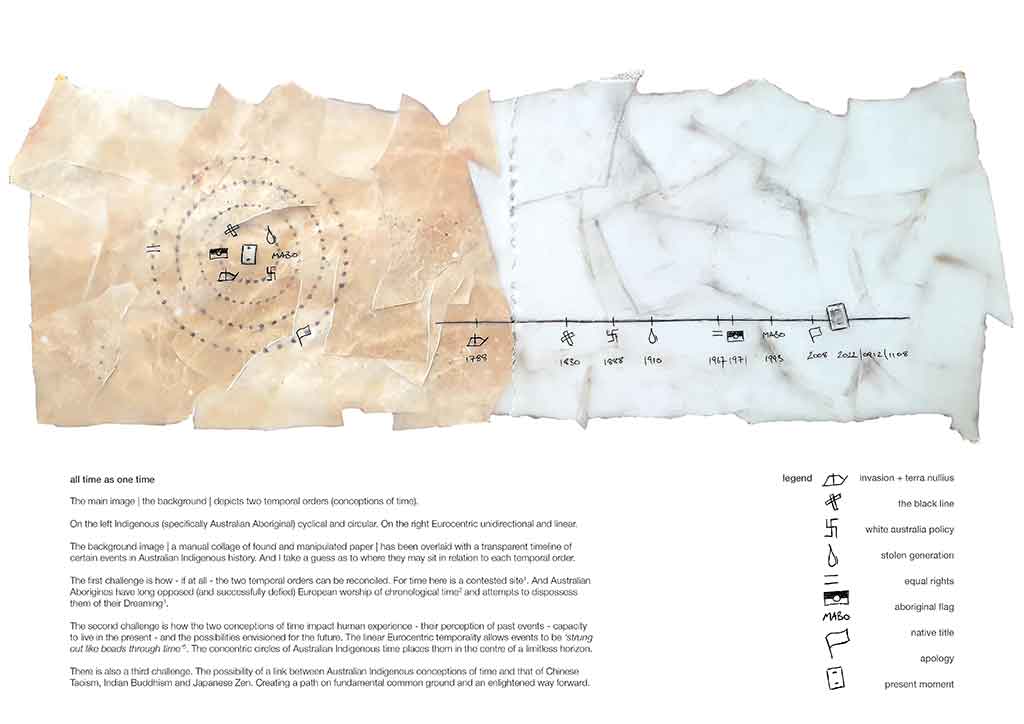The End Of Time
The main image | the background | depicts two temporal orders (conceptions of time). On the left Indigenous (specifically Australian Aboriginal) cyclical and circular. On the right Eurocentric unidirectional and linear.
The background image | a manual collage of found and manipulated paper | has been overlaid with a transparent timeline of certain events in Australian Indigenous history. And I take a guess as to where they may sit in relation to each temporal order.
The first challenge is how – if at all – the two temporal orders can be reconciled. For time here – is a contested site1. And Australian Aborigines have long opposed (and successfully defied) European worship of chronological time2 and attempts to dispossess them of their Dreaming3. Thereby preventing the extinction of their temporal order. And frustrating those who live in constant pursuit of capital and power and economic growth – the ‘great tomorrow’4. However in doing so they have been pathogolized2 by the radical imposition of foreign – and to them nonsensical – mechanical time and the ‘meaningless toil’3 it invokes. Subsequently – in many ways – they have been ‘closed out of the future’3. And in that context time has also become a social justice issue2.
The second challenge is how the two conceptions of time impact human experience – their perception of past events – capacity to live in the present – and the possibilities envisioned for the future. The linear Eurocentric temporality allows events to be ‘strung out like beads through time’5. The concentric circles of Australian Indigenous time does not. Instead the narratives of Aboriginal lives move through circles towards and away from the centre where the person is situated2. Events that hold more weight sit closer to the centre. Regardless of when they occurred in chronological time. They have knowledge – and a view – of a limitless temporal horizon. For Europeans events – and their weight – disappear along – and often completely off – their linear line of time. The ‘past trails and vanishes like the wake of a ship’6. For Australian Aborigines however, the ‘past contains the present, and the present represents the past’5. Current time is always and forever imbued with history. What ultimately happens – for example – to a child’s grief when her Mother dies depends on the way your view time2. So too perhaps, atrocities like the war known as The Black Line and assimilation policies and practices that led to The Stolen Generation6.
There is also a third challenge. The possibility of a link between Australian Indigenous conceptions of time and that of Chinese Taoism, Indian Buddhism and Japanese Zen. Creating a path on fundamental common ground and an enlightened way forward. One of Sydney’s earliest white settlers once remarked, ‘all savages place happiness in inaction’2. He uses the word ‘savage’ to specifically describe Australian Aborigines and the phrase ‘happiness in inaction’ to describe laziness. However this happiness in inaction can be applied / extended to all monks and masters worldwide. For they too agree that there is absolutely nothing to seek – trade time for – grasp at or clutch. Experience all time as one time. And all live life in the ‘everywhen’7. As ‘there isn’t anywhere, anywhen, {or any where else} to be’6.
NOTES
- Lattas
- Renoylds Barre
- Donaldson
- Hodkinson
- Bell
- Wats
- Bodle
- Stanner
For
Griffith University ⎮Indigenous Champion Service Role.
Prompt
The piece is a response to an assignment brief - “produce a two-sided poster (digital or hand-drawn) that communicates a comparative perspective of a ‘deadly/wicked challenge’ + legend + 250 word reflection explanation”.
Artwork
‘all time as one time’ ⎮ mixed media ⎮ manual collage of found and manipulated paper ⎮ charcoal ⎮ graphite ⎮ fine-liners.
Artwork Size
800mm x 350mm ⎮ Landscape
Completion Date
09⎮ 12 ⎮ 2022
Publication Date (Self Published)
15⎮ 11 ⎮ 2023

